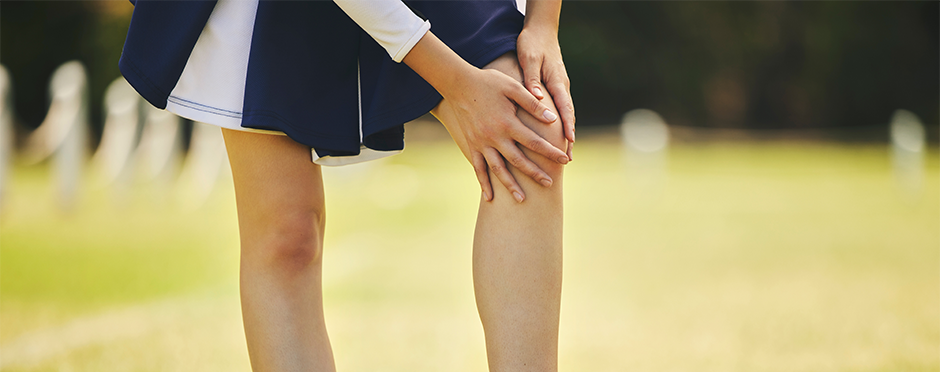
Understanding Lower Extremity Injuries in Cheerleaders and Gymnasts
Leave a CommentCheerleading and gymnastics are incredibly demanding sports requiring strength, flexibility, and precision. Yet, they also carry a significant risk of injury, particularly in the lower extremities.
The prevalence of lower extremity injuries in cheerleading and gymnastics worldwide has increased significantly over the last decade as both sports have evolved1,2. One study, including 6-to-17-year-old gymnasts, found that the lower extremity was the most affected site of injury (60.5%), with the ankle/foot and knee joints accounting for 49% and 27% of injuries, respectively. This study also found that 10-to-12-year-olds and 13-to-17-year-olds were at greater risk for lower extremity injury due to increased growth rates compared to 6-to-9-year-olds2.
The nature of injuries often sustained in cheerleading and gymnastics are related to the athlete’s age and repetitive activities. Collegiate/Elite cheerleaders and gymnasts tend to be older and are likely to sustain a traumatic injury that requires surgery. This is due to the increased force and loading demands by those with elite skills2. Overuse injuries can affect many tissues including, ligaments, muscles, tendons, and bones. In children, these structures are still growing, and that growth occurs unevenly. For example, bones grow at a faster rate than muscles. This uneven growth causes the muscle, tendon, and growth plates to be seen as vulnerable areas for overuse injuries to occur3.
Common Types of Overuse Injuries
Osgood-Schlatter Disease
Osgood-Schlatter disease causes inflammation of the bone at the growth plate at the front of the shin below the kneecap (tibial tubercle). The repetitive jumping and running cause a traction force at the insertion of the patellar tendon into the tibia that can lead to a stress reaction or stress fracture if the athlete’s activity level is not decreased3.
Sever’s Disease
Sever’s disease causes inflammation of the calcaneus (heel bone) at the growth plate. Repetitive jumping and running activities result in a traction force at the insertion of the Achilles tendon on the calcaneus, which can lead to further injury to the bone if the athlete’s activity level is not decreased3.
Medial Tibial Stress Syndrome (MTSS)
Medial Tibial Stress Syndrome, or MTSS, is an early stress injury in the continuum of a tibial stress fracture, which often is referred to as “Shin Splints.” Repetitive muscle traction of the tibialis anterior (shin muscles) can result in a fracture of the tibia bone if the repetitive activity is not stopped4.
Patellar Tendinopathy
Patellar Tendinopathy, often referred to as “Jumper’s Knee,” is inflammation of the patellar tendon insertion on the kneecap caused by repetitive quadriceps muscle contractions during jumping and running activities3.
Achilles Tendinopathy
Achilles Tendinopathy is caused by inflammation of the Achilles tendon insertion into the calcaneus (heel bone). This inflammation is caused by repetitive gastrocnemius complex contractions resulting from running and jumping activities3.
Osteochondritis Dissecans (OCD)
With Osteochondritis Dissecans, or OCD, small segments of bone in the knee and ankle begin to separate due to high repetitive forces and decreased blood supply to the area. A piece of bone and cartilage can separate from the rest of the bone in a joint, resulting in a loss of range of motion. Rest and activity modification are important to avoid surgery5.
Meniscus Tear
Gradual degeneration of the meniscus, the cartilage that cushions between the shinbone (tibia) and thighbone (femur), can progress into tears. A tear in areas of low blood supply, in certain patterns/locations, may require surgery1,3.
Other Ligament Sprains
Repetitive forces cause ligamentous breakdown in the knee and ankle, resulting in a tear in the tissue that can be acute (1 time) or chronic (repetitive stress) 1,3,6.
Symptoms of Overuse Injuries
- Pain during or after activity
- Tenderness
- Swelling
- Changes in form or technique
- Decreased interest in practice
How to Reduce Risk for Athletes
The prevalence of overuse injuries among gymnasts is a significant concern. It is rooted in repetitive training, inadequate recovery, early sports specialization, and biomechanical deficiencies1,2,8. Addressing these issues through a comprehensive physical therapy approach can substantially reduce the risk of injury. By focusing on individualized treatment plans that enhance strength, flexibility, and technique, physical therapists empower gymnasts and cheerleaders to maintain peak performance while safeguarding their long-term health. Proactive measures in physical therapy promote injury prevention and contribute to more sustainable training practices, allowing gymnasts and cheerleaders to continue participating in the sports they love.
Find a Gymnastics/Cheerleading Specialist Near You
The Athletico blog is an educational resource written by Athletico employees. Athletico bloggers are licensed professionals who abide by the code of ethics outlined by their respective professional associations. The content published in blog posts represents the opinion of the individual author based on their expertise and experience. The content provided in this blog is for informational purposes only, does not constitute medical advice and should not be relied on for making personal health decisions
References:
1. Injury epidemiology and risk factors in competitive artistic gymnasts: a systematic review – PubMed (nih.gov)
2. Injury Pathology in Young Gymnasts: A Retrospective Analysis – PubMed (nih.gov)
3. https://orthoinfo.aaos.org/en/diseases–conditions/overuse-injuries-in-children/
4. Medial Tibial Stress Syndrome – StatPearls – NCBI Bookshelf (nih.gov)
5. https://orthoinfo.aaos.org/en/diseases–conditions/osteochondritis-dissecans/
6. https://www.ncbi.nlm.nih.gov/pmc/articles/PMC6905051/
7. https://blogs.bmj.com/bjsm/2022/09/30/monitoring-training-load-in-artistic-gymnastics/
8. https://usacheer.org/3-common-risk-factors-for-stress-fractures-and-how-to-avoid-them
